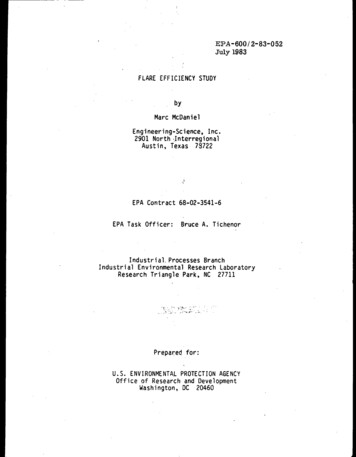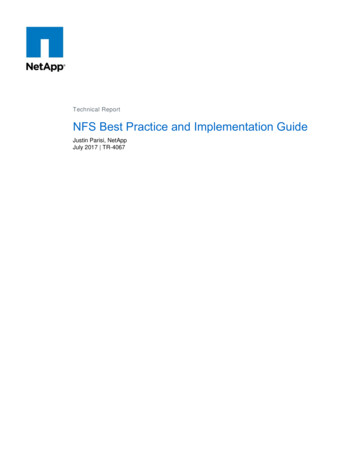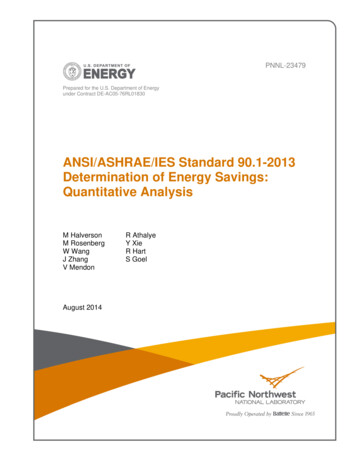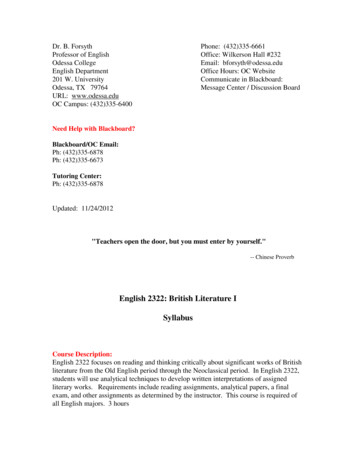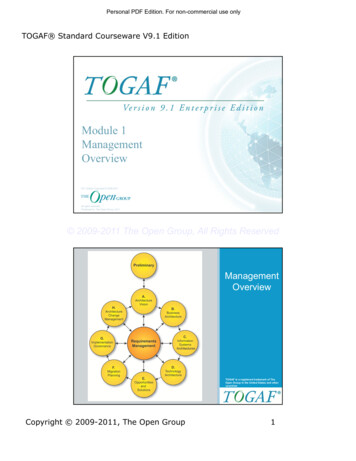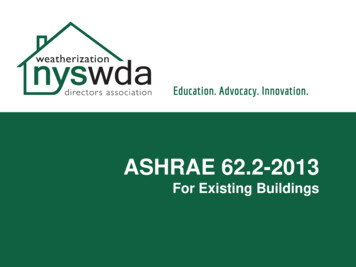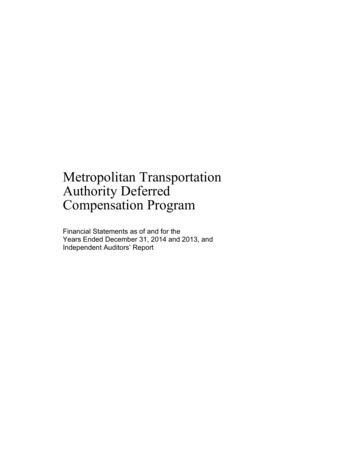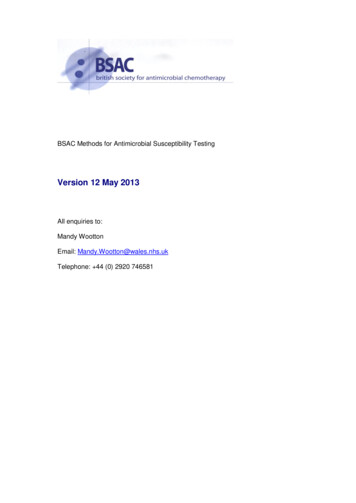
Transcription
BSAC Methods for Antimicrobial Susceptibility TestingVersion 12 May 2013All enquiries to:Mandy WoottonEmail: Mandy.Wootton@wales.nhs.ukTelephone: 44 (0) 2920 746581
ContentsWorking Party membersPage5Abstract6Preface8Disc Diffusion Method for Antimicrobial Susceptibility Testing1. Preparation of plates102. Selection of control organismsTable2aControl strains to monitor test performance of antimicrobial susceptibilitytesting2bControl strains used to confirm that the method will detect resistance113. Preparation of inoculum3.1Comparison with 0.5 McFarland standard3.1.1Preparation of the McFarland standard3.1.2Inoculum preparation by the growth method3.1.3Inoculum preparation by the direct colony suspension method3.1.4Adjustment of the organism suspension to the density of the 0.5McFarland standard3.1.5Dilution of suspension equivalent to 0.5 McFarland standard in distilledwater before inoculation3.2Photometric standardisation of turbidity of suspension3.3Direct susceptibility testing of urines and blood cultures1213131313134. Inoculation of agar plates165. Antimicrobial discs5.1Storage and handling of discs5.2Application of discs1616166. Incubation6.1Conditions of incubation16167. Measuring zones and interpretation of susceptibility7.1Acceptable inoculum density7.2Measuring zones7.3Use of templates for interpreting susceptibility181818188. Oxacillin/cefoxitin testing of staphylococci8.1Detection of oxacillin resistance in Staphylococcus aureus andcoagulase negative staphylococci8.2Detection of methicillin/oxacillin/cefoxitin resistance in staphylococci byuse of cefoxitin as test agent1919121213141520Interpretative tablesTable6789MIC and zone breakpoints for:EnterobacteriaceaeAcinetobacter speciesPseudomonasStenotrophomonas maltophiliaVersion 12 January 2013222728302
Interpretative tables continued10Staphylococci11Streptococcus pneumoniae12Enterococci13-haemolytic streptococci14-haemolytic streptococci15Moraxella catarrhalis16Neisseria gonorrhoeae17Neisseria meningitidis18Haemophilus influenzae19Pasteurella multocida20Campylobacter spp.21Coryneform organisms22Gram-negative anaerobes23Gram-positive anaerobes except Clostridium difficile24Clostridium ces12Advice on testing the susceptibility to co-trimoxazoleEfficacy of cefaclor in the treatment of respiratory infections caused byHaemophilus al information1Susceptibility testing of Helicobacter pylori2Susceptibility testing of Brucella species3Susceptibility testing of Legionella species4Susceptibility testing of Listeria species5Susceptibility testing of topical antibiotics6Development of MIC and zone diameter breakpoints676767686869Control of disc diffusion antimicrobial susceptibility testing1Control strains2Maintenance of control strains3Calculation of control ranges for disc diffusion4Frequency of routine testing with control strains5Use of control data to monitor the performance of disc diffusion tests6Recognition of atypical results for clinical isolates7Investigation of possible sources of error8Reporting susceptibility results when controls indicate problems7070707070717172Table237376456Acceptable ranges for control strains for:Iso-Sensitest agar incubated at 35-370C in air for 18-20hIso-Sensitest agar supplemented with 5% defibrinated horse blood,with or without the addition of NAD, incubated at 35-370C in air for 1820hDetection of methicillin/oxacillin/cefoxitin resistance in staphylococciIso-Sensitest agar supplemented with 5% defibrinated horse blood,with or without the addition of NAD, incubated at 35-370C in 10%CO2/10% H2 /80% N2 for 18-20 hIso-Sensitest agar supplemented with 5% defibrinated horse blood,with or without the addition of NAD, incubated at 35-370C in 4-6% CO2for 18-20 hVersion 12 January 20137677783
Page9. Control of MIC determinationsTableTarget MICs for:7Haemophilus influenzae, Enterococcus faecalis, Streptococcuspneumoniae, Bacteroides fragilis and Neisseria gonorrhoeae8Escherichia coli, Pseudomonas aeruginosa and Staphylococcusaureus9Pasteurella multocida10Bacteroides fragilis, Bacteroides thetaiotaomicron and Clostridiumperfringens11Group A l web sites87Version 12 January 20134
Working Party Members:Dr Robin Howe(Chairman)Consultant MicrobiologistPublic Health Wales UniversityHospital of WalesHeath ParkCardiffCF14 4XWProfessor David LivermoreProfessor of Medical MicrobiologyFaculty of Medicine & HealthSciencesNorwich Medical SchoolUniversity of East AngliaNorwich Research ParkNorwichNR4 7TJDr Derek Brown(Scientific Secretary for EUCAST)Dr. Karen BowkerClinical ScientistSouthmead HospitalWestbury-on-TrymBristolBS10 5NBDr. Mandy Wootton(Acting Secretary)Lead ScientistPublic Health WalesUniversity Hospital of WalesHeath ParkCardiffCF14 4XWDr Nicholas BrownConsultant MicrobiologistClinical Microbiology HPALevel 6Addenbrooke's HospitalHills RoadCambridgeCB2 2QWMr Christopher TealeVeterinary Lab AgencyKendal RoadHarlescottShrewsburyShropshireSY1 4HDDr. Gerry GlynnMedical MicrobiologistMicrobiology DepartmentAltnagelvin HospitalGlenshane RoadLondonderryN. IrelandBT47 6SBProfessor Alasdair MacGowanConsultant MedicalMicrobiologistSouthmead HospitalWestbury-on-TrymBristolBS10 5NBDr Trevor WinstanleyClinical ScientistDepartment of MicrobiologyRoyal Hallamshire HospitalGlossop RoadSheffieldS10 2JFProfessor Gunnar KahlmeterCentral LasarettetKlinisk MikrobiologiskaLaboratoriet351 85 VaxjoSwedenDr. Fiona MacKenzieMedical MicrobiologyAberdeen Royal InfirmaryForesthillAberdeenAB25 2ZNMs Phillipa J BurnsSenior BMS MicrobiologyDepartment of MedicalMicrobiologyManchester Medical MicrobiologyPartnership, HPA & CentralManchester Foundation TrustManchesterM13 9WZAll enquiries to Mandy WoottonEmail: Mandy.Wootton@wales.nhs.ukTelephone: 44 (0) 2920 746581Version 12 January 20135
AbstractSummary of changes in version 12Table 6. MIC and zone diameter breakpoints for Enterobacteriaceae (including Salmonella,Shigella spp. and Yersinia enterocolitica)MIC and zone diameter breakpoints for Y. enterocoliticaTetracyclineTable 8. MIC and zone diameter breakpoints for Pseudomonas spp.Note to the tableTable 10. MIC and zone diameter breakpoints for staphylococciMIC and zone diameter breakpointsLevofloxacinCommentsSusceptibility testing of S. saprophyticus under reviewMedium that should be used to test daptomycinRe-instatement of the comment for mupirocinTable 11. MIC and zone diameter breakpoints for Streptococcus pneumoniaeMIC and zone diameter breakpointsClindamycinTable 12. MIC and zone diameter breakpoints for enterococciMIC and zone diameter breakpointsAmoxicillinTable 16. MIC and zone diameter breakpoints for Neisseria gonorrhoeaeRemoval of disc testing tsUse of cefuroxime screenTable 19. MIC and zone diameter breakpoints for Pasteurella multocidaChanges in MIC and zone diameter yclineCommentsDisc breakpoints under reviewVersion 12 January 20136
Table 20. MIC and zone diameter breakpoints for Campylobacter spp.Change in MIC breakpointCiprofloxacinVersion 12 January 20137
PrefaceSince the Journal of Antimicrobial Chemotherapy Supplement containing the BSAC standardizeddisc susceptibility testing method was published in 2001, there have been various changes to therecommendations and these have been posted on the BSAC website (http://www.bsac.org.uk).One major organizational change has been the harmonisation of MIC breakpoints in Europe.In 2002 the BSAC agreed to participate with several other European national susceptibilitytesting committees, namely CA-SFM (Comité de l‟Antibiogramme de la Société Française deMicrobiologie, France), the CRG (Commissie Richtlijnen Gevoeligheidsbepalingen (TheNetherlands), DIN (Deutsches Institut für Normung, Germany), NWGA (Norwegian WorkingGroup on Antimicrobials, Norway) and the SRGA (Swedish Reference Group of Antibiotics,Sweden), in a project to harmonize antimicrobial breakpoints, including previously establishedvalues that varied among countries. This work is being undertaken by the European Committeeon Antimicrobial Susceptibility Testing (EUCAST) with the support and collaboration of thenational committees, and is funded by the European Union, the European Society for ClinicalMicrobiology and Infectious Diseases (ESCMID) and the national committees, including theBSAC. The review process includes application of more recent techniques, such aspharmacodynamic analysis, and current data, where available, on susceptibility distributions,resistance mechanisms and clinical outcomes as related to in vitro tests. There is extensivediscussion between EUCAST and the national committees, including the BSAC Working Partyon antimicrobial susceptibility testing, and wide consultation on proposals. In the interest ofinternational standardization of susceptibility testing, and the need to update older breakpoints,these developments are welcomed by the BSAC.The implication of such harmonization is that over time some MIC breakpoints will changeslightly and these changes will be reflected, where necessary, in corresponding changes to zonediameter breakpoints in the BSAC disc diffusion method. It is appreciated that changes in themethod require additional work for laboratories in changing templates and laboratory informationsystems, and that the wider use of intermediate‟ categories will add complexity. Neverthelessthe benefits of international standardization are considerable, and review of some olderbreakpoints is undoubtedly warranted.In line with the European consensus EUCAST MIC breakpoints are defined as follows:Clinically resistant: level of antimicrobial susceptibility which results in a high likelihood oftherapeutic failureClinically susceptible: level of antimicrobial susceptibility associated with a high likelihood oftherapeutic successClinically intermediate: a level of antimicrobial susceptibility associated with uncertaintherapeutic effect. It implies that an infection due to the isolate may be appropriately treated inbody sites where the drugs are physically concentrated or when a high dosage of drug can be8Version 12 January 2013
used; it also indicates a buffer zone that should prevent small, uncontrolled, technical factorsfrom causing major discrepancies in interpretation.The presentation of MIC breakpoints (mg/L) has also been amended to avoid the theoretical„gap‟ inherent in the previous system as follows:MIC(as previously) MIC breakpoint concentration organism is susceptibleMIC (previously ) MIC breakpoint concentration organism is resistantIn practice, this does result in changes to breakpoint systems based on two-fold dilutions.However, the appearance of the tables will change, e.g. R 16, S 8 will change to R 8, S 8.Version 12 January 20139
Disc Diffusion Method for Antimicrobial Susceptibility Testing1.Preparation of plates1.1 Prepare Iso-Sensitest agar (ISA) (see list of suppliers) or media shown to have the sameperformance as ISA, according to the manufacturer‟s instructions. Supplement media forfastidious organisms with 5% defibrinated horse blood or 5% defibrinated horse blood and20 mg/L -nicotinamide adenine dinucleotide (NAD) as indicated in Table 1. Use Columbiaagar with 2% NaCl for methicillin/oxacillin susceptibility testing of staphylococci.Table 1: Media and supplementation for antimicrobial susceptibility testing of different groups udomonas spp.ISAStenotrophomonas maltophiliaISAStaphylococci (tests other thanmethicillin/oxacillin)Staphylococcus aureus (tests using cefoxitin todetect methicillin/oxacillin/cefoxitin resistance)Staphylococci (tests using methicillin or oxacillinfor the detection of cciISAStreptococcus pneumoniaeISA 5% defibrinated horse blood2-Haemolytic streptococci-Haemolytic streptococciISAColumbia agar (see suppliers) with 2%NaCl1ISAISA 5% defibrinated horse blood 20mg/L NADISA 5% defibrinated horse blood2Moraxella catarrhalisISA 5% defibrinated horse blood2Haemophilus spp.Neisseria gonorrhoeaeISA 5% defibrinated horse blood 20mg/L NADISA 5% defibrinated horse blood2Neisseria meningitidisISA 5% defibrinated horse blood2Pasteurella multocidaISA 5% defibrinated horse blood 20mg/L NADISA 5% defibrinated horse blood 20mg/L NADISA 5% defibrinated horse blood2Bacteroides fragilis, Bacteroidesthetaiotaomicron, Clostridium perfringensCampylobacter spp.Coryneform organisms12ISA 5% defibrinated horse blood 20mg/L NADSee Section 8.ISA supplemented with 5% defibrinated horse blood 20mg/L NAD may be used.Version 12 January 201310
1.2Pour sufficient molten agar into sterile Petri dishes to give a depth of 4 mmmL in 90 mm diameter Petri dishes).0.5 mm (251.3 Dry the surface of the agar to remove excess moisture before use. The length of timeneeded to dry the surface of the agar depends on the drying conditions, e.g. whether a fanassisted drying cabinet or „still air‟ incubator is used, whether plates are dried beforestorage and storage conditions. It is important that plates are not over dried.1.4 Store the plates in vented plastic boxes at 8-10 C prior to use. Alternatively the plates maybe stored at 4-8 C in sealed plastic bags. Plate drying, method of storage and storage timeshould be determined by individual laboratories as part of their quality assuranceprogramme. In particular, quality control tests should confirm that excess surface moistureis not produced and that plates are not over-dried.2.Selection of control organisms2.1 The performance of the tests should be monitored by the use of appropriate control strains(see section on control of antimicrobial susceptibility testing). The control strains listed(Tables 2a, 2b) include susceptible strains that have been chosen to monitor testperformance and resistant strains that can be used to confirm that the method will detect amechanism of resistance.2.2 Store control strains at –70 C on beads in glycerol broth. Non-fastidious organisms may bestored at –20 C. Two vials of each control strain should be stored, one for an „in-use‟supply, the other for archiving.2.3 Every week subculture a bead from the „in-use‟ vial on to appropriate non-selective mediaand check for purity. From this pure culture, prepare one subculture on each of thefollowing 5 days. For fastidious organisms that will not survive on plates for 5/6 days,subculture the strain daily for no more than 6 days.Version 12 January 201311
Table 2a: Susceptible control strains or control strains with low-level resistance that have beenchosen to monitor test performance of antimicrobial susceptibility testingStrainOrganismEscherichia coliStaphylococcus aureusPseudomonas aeruginosaEnterococcus faecalisHaemophilus influenzaeStreptococcus pneumoniaeNeisseria gonorrhoeaePasteurella multocidaBacteroides fragilisBacteroides thetaiotaomicronClostridium perfringensEitherNCTC 12241(ATCC 25922)NCTC 12981(ATCC 25923)NCTC 12903(ATCC 27853)NCTC 12697(ATCC 29212)NCTC 11931OrCharacteristicsNCTC 10418SusceptibleNCTC 6571SusceptibleNCTC 10662SusceptibleSusceptibleSusceptibleNCTC 12977(ATCC 49619)NCTC 12700(ATCC 49226)NCTC 8489Low-level resistantto penicillinLow-level resistantto penicillinSusceptibleNCTC 9343(ATCC 25285)ATCC 29741SusceptibleNCTC 8359(ATCC 12915)SusceptibleSusceptibleTable 2b: Control strains with a resistance mechanism that can be used to confirm that the methodwill detect resistance.Organism3.StrainEscherichia coliNCTC 11560Staphylococcus aureusNCTC 12493Haemophilus influenzaeNCTC 12699(ATCC 49247)CharacteristicsTEM-1 ß-lactamaseproducerMecA positive,methicillin resistantResistant to ßlactams (ßlactamase-negative)Preparation of inoculumThe inoculum should give semi-confluent growth of colonies after overnight incubation. Use ofan inoculum that yields semi-confluent growth has the advantage that an incorrect inoculum caneasily be observed. A denser inoculum will result in reduced zones of inhibition and a lighterinoculum will have the opposite effect. The following methods reliably give semi-confluentgrowth with most isolates.NB. Other methods of obtaining semi-confluent growth may be used if they are shown to beequivalent to the following.Version 12 January 201312
3.1 Comparison with a 0.5 McFarland standard3.1.1Preparation of the 0.5 McFarland standardAdd 0.5 mL of 0.048 M BaCl2 (1.17% w/v BaCl2. 2H2O) to 99.5 mL of 0.18 M H2SO4 (1%w/v) with constant stirring. Thoroughly mix the suspension to ensure that it is even.Using matched cuvettes with a 1 cm light path and water as a blank standard, measurethe absorbance in a spectrophotometer at a wavelength of 625 nm. The acceptableabsorbance range for the standard is 0.08-0.13. Distribute the standard into screw-captubes of the same size and volume as those used in growing the broth cultures. Seal thetubes tightly to prevent loss by evaporation. Store protected from light at roomtemperature. Vigorously agitate the turbidity standard on a vortex mixer before use.Standards may be stored for up to six months, after which time they should be discarded.Prepared standards can be purchased (See list of suppliers), but commercial standardsshould be checked to ensure that absorbance is within the acceptable range as indicatedabove.3.1.2Inoculum preparation by the growth method (for non-fastidious organisms, e.g.Enterobacteriaceae, Pseudomonas spp. and staphylococci)Touch at least four morphologically similar colonies (when possible) with a sterile loop.Transfer the growth into Iso-Sensitest broth or an equivalent that has been shown not tointerfere with the test. Incubate the broth, with shaking at 35-37 C, until the visibleturbidity is equal to or greater than that of a 0.5 McFarland standard.3.1.3Inoculum preparation by the direct colony suspension method (the method of choice forfastidious organisms, i.e. Haemophilus spp., Neisseria gonorrhoeae, Neisseriameningitidis, Moraxella catarrhalis, Streptococcus pneumoniae, and -haemolyticstreptococci, Clostridium perfringens, Bacteroides fragilis, Bacteroides thetaiotaomicron,Campylobacter spp., Pasteurella multocida and Coryneform organisms).Colonies are taken directly from the plate into Iso-Sensitest broth (or equivalent) or steriledistilled water. The density of the suspension should match or exceed that of a 0.5McFarland standard.NB. With some organisms production of an even suspension of the required turbidity isdifficult and growth in broth, if possible, is a more satisfactory option.3.1.4Adjustment of the organism suspension to the density of a 0.5 McFarland standardAdjust the density of the organism suspension to equal that of a 0.5 McFarland standardby adding sterile distilled water. To aid comparison, compare the test and standardsuspensions against a white background with a contrasting black line.NB. Suspension should be used within 15 min.3.1.5Dilution of suspension in distilled water before inoculationDilute the suspension (density adjusted to that of a 0.5 McFarland standard) in distilledwater as indicated in Table 3.Version 12 January 201313
Table 3: Dilution of the suspension (density adjusted to that of a 0.5 McFarland standard) in distilledwaterDilute1:100-Haemolytic as spp.Stenotrophomonas maltophiliaAcinetobacter spp.Haemophilus spp.Pasteurella multocidaBacteroides fragilisBacteroides thetaiotaomicronDilute1:10StaphylococciSerratia spp.Streptococcus pneumoniaeNeisseria meningitidisMoraxella catarrhalis-haemolytic streptococciClostridium perfringensCoryneform organismsNo dilutionNeisseria gonorrhoeaeCampylobacter spp.NB. These suspensions should be used within 15 min of preparation.3.2 Photometric standardization of turbidity of suspensionsA photometric method of preparing inocula was described by Moosdeen et al (1988)1 and fromthis the following simplified procedure has been developed. The spectrophotometer must have acell holder for 100 x 12 mm test tubes. A much simpler photometer would also probably beacceptable. The 100 x 12 mm test tubes could also be replaced with another tube/cuvettesystem if required, but the dilutions would need to be recalibrated.3.2.1 Suspend colonies (touch 4-5 when possible) in 3 mL distilled water or broth in a 100 x 12mm glass tube (note that tubes are not reused) to give just visible turbidity. It is essential toget an even suspension.NB. These suspensions should be used within 15 min of preparation.3.2.2 Zero the spectrophotometer with a sterile water or broth blank (as appropriate) at awavelength of 500 nm and measure the absorbance of the bacterial suspension.3.2.3 From table 4 select the volume to transfer (with the appropriate fixed volume micropipette)to 5 mL sterile distilled water.3.2.4 Mix the diluted suspension to ensure that it is evenNB. Suspension should be used within 15 min. of preparationVersion 12 January 201314
Table 4: Dilution of suspensions of test organisms according to absorbance readingAbsorbance reading at500 s spp.StaphylococciHaemophilus spp.StreptococciMiscellaneous fastidiousOrganisms0.01 - 0.05 0.05 - 0.1 0.1 - 0.3 0.3 - 0.6 0.6 - 1.00.01 - 0.05 0.05 - 0.1 0.1 - 0.3 0.3 - 0.6 0.6 - 1.0Volume ( L) to transfer to5 mL sterile distilled water2501254020105002501258040NB. As spectrophotometers may differ, it may be necessary to adjust the dilutions slightly toachieve semi-confluent growth with any individual set of laboratory conditions.3.3 Direct antimicrobial susceptibility testing of urine specimens and blood culturesDirect susceptibility testing is not advocated as the control of inoculum is very difficult. Directtesting is, however, undertaken in many laboratories in order to provide more rapid test results.The following methods have been recommended by laboratories that use the BSAC method and.will achieve the correct inoculum size for a reasonable proportion of infected urines and bloodcultures If the inoculum is not correct (i.e. growth is not semi-confluent) or the culture is mixed,the test must be repeated.3.3.1 Urine specimens3.3.1.1 Method 1Thoroughly mix the urine specimen, then place a 10 L loop of urine in the centre ofthe susceptibility plate and spread evenly with a dry swab.3.3.1.2 Method 2Thoroughly mix the urine specimen, then dip a sterile cotton-wool swab in the urineand remove excess by turning the swab against the inside of the container. Use theswab to make a cross in the centre of the susceptibility plate and spread evenly withanother sterile dry swab. If only small numbers of organisms are seen inmicroscopy, the initial cotton-wool swab may be used to inoculate and spread thesusceptibility plate.3.3.2 Positive blood culturesThe method depends on the Gram reaction of the infecting organism.3.3.2.1 Gram-negative bacilli.Using a venting needle, place one drop of the blood culture in 5 mL of sterile water,then dip a sterile cotton-wool swab in the suspension and remove excess by turningthe swab against the inside of the container. Use the swab to spread the inoculumevenly over the surface of the susceptibility plate.3.3.2.2 Gram-positive organisms.It is not always possible accurately to predict the genera of Gram-positive organismsfrom the Gram‟s stain. However, careful observation of the morphology, coupledwith clinical information, should make an “educated guess” correct most of the time.Version 12 January 201315
Staphylococci and enterococci.Using a venting needle, place three drops of the blood culture in 5 mL of sterilewater, then dip a sterile cotton-wool swab in the suspension and remove excess byturning the swab against the inside of the container. Use the swab to spread theinoculum evenly over the surface of the susceptibility plate.Pneumococci, “viridans” streptococci and diptheroids.Using a venting needle, place one drop of the blood culture in the centre of asusceptibility plate, and spread the inoculum evenly over the surface of the plate.4. Inoculation of agar plateUse the adjusted suspension within 15 min to inoculate plates by dipping a sterile cotton-wool swabinto the suspension and remove the excess liquid by turning the swab against the side of thecontainer. Spread the inoculum evenly over the entire surface of the plate by swabbing in threedirections. Allow the plate to dry before applying discs.NB. If inoculated plates are left at room temperature for extended times before the discs are applied,the organism may begin to grow, resulting in reduced zones of inhibition. Discs should therefore beapplied to the surface of the agar within 15 min of inoculation.5.Antimicrobial discsRefer to interpretation tables 6-23 for the appropriate disc contents for the organisms tested.5.1 Storage and handling of discs.Loss of potency of agents in discs will result in reduced zones of inhibition. To avoid loss ofpotency due to inadequate handling of discs the following are recommended:5.1.1Store discs in sealed containers with a desiccant and protected from light (thisis particularly important for some light-susceptible agents such asmetronidazole, chloramphenicol and the quinolones).5.1.2Store stocks at -20 C except for drugs known to be unstable at thistemperature. If this is not possible, store discs at 8 C.5.1.3Store working supplies of discs at 8 C.5.1.4To prevent condensation, allow discs to warm to room temperature beforeopening containers.5.1.5Store disc dispensers in sealed containers with an indicating desiccant.5.1.6Discard discs on the expiry date shown on the side of the container.5.2 Application of discsDiscs should be firmly applied to the dry surface of the inoculated susceptibility plate. Thecontact with the agar should be even. A 90 mm plate will accommodate six discs withoutunacceptable overlapping of zones.6.IncubationIf the plates are left for extended times at room temperature after discs are applied, larger zones ofinhibition may be obtained compared with zones produced when plates are incubated immediately.Plates should therefore be incubated within 15 min of disc application.6.1 Conditions of incubationIncubate plates under conditions listed in table 5.Version 12 January 201316
Table 5: Incubation conditions for antimicrobial susceptibility tests on various organismsOrganismsEnterobacteriaceaeAcinetobacter spp.Pseudomonas spp.Stenotrophomonas maltophiliaStaphylococci (other thanmethicillin/oxacillin/cefoxitin)Staphylococcus aureus using cefoxitin for thedetection of occi using methicillin or oxacillin todetect resistanceMoraxella catarrhalisIncubation conditions35-37 C in air for 18-20 h35-37 C in air for 18-20 h35-37 C in air for 18-20 h30 C in air for 18-20 h35-37 C in air for 18-20 h35 C in air for 18-20 h30 C in air for 24 h-Haemolytic streptococci-Haemolytic streptococciEnterococciNeisseria meningitidisStreptococcus pneumoniae35-37 C in air for 18-20 h35-37 C in 4-6% CO2 in air for 18-20 h35-37 C in air for 18-20 h35-37 C in air for 24 h135-37 C in 4-6 % CO2 in air for 18-20 h35-37 C in 4-6 % CO2 in air for 18-20 hHaemophilus spp.Neisseria gonorrhoeaePasteurella multocidaCoryneform organisms35-37 C in 4-6 % CO2 in air for 18-20 h35-37 C in 4-6 % CO2 in air for 18-20 h35-37 C in 4- 6% CO2 in air for 18-20 h35-37 C in 4-6% CO2 in air for 18-20 hCampylobacter spp.Bacteroides fragilis, Bacteroidesthetaiotaomicron, Clostridium perfringens42 C in microaerophilic conditions for 24 h35-37 C in 10% CO2/10% H2/80% N2 for18-20 h (anaerobic cabinet or jar)1It is essential that plates are incubated for at least 24 h before reporting a strain as susceptibleto vancomycin or teicoplanin.NB. Stacking plates too high in the incubator may affect results owing to uneven heating of plates.The efficiency of heating of plates depends on the incubator and the racking system used. Control ofincubation, including height of plate stacking, should therefore be part of the laboratory‟s QualityAssurance programme.Version 12 January 201317
7.Measuring zones and interpretation of susceptibility7.1 Acceptable inoculum densityThe inoculum should give semi-confluent growth of colonies on the susceptibility plate, within therange illustrated in Figure 1.Figure 1: Acceptable inoculum density range for a Gram-negative rodLightest acceptableIdealHeaviest acceptable7.2 Measuring zones7.2.1 Measure the diameters of zones of inhibition to the nearest millimetre (zone edge should betaken as the point of inhibition as judged by the naked eye) with a ruler, callipers or anautomated zone reader.7.2.2 Tiny colonies at the edge of the zone, films of growth as a result of the swarming of Proteus spp.and slight growth within sulphonamide or trimethoprim zones should be ignored.7.2.3 Colonies growing within the zone of inhibition should be subcultured and identified and the testrepeated if necessary.7.2.4 When using cefoxitin for the detection of methicillin/oxacillin/cefoxitin resistance in S. aureus,measure the obvious zone, taking care to examine zones carefully in good light to detect minutecolonies that may be present within the zone of inhibition (see Figure 3)7.2.5 Confirm that the zone of inhibition for the control strain falls within the acceptable ranges inTables 20-23 before interpreting the test (see section on control of the disc diffusion method).7.3 Use of templates for interpreting zone diametersA template may be used for interpreting zone diameters (see Figure 2). A program for preparingtemplates is available from the BSAC (http://www.bsac.org.uk).The test plate is placed over the template and the zones of inhibition are examined in relationship tothe template zones. If the zone of inhibition of the test strain is within the area marked with an „R‟, theorganism is resistant. If the zone of inhibition is eq
Disc Diffusion Method for Antimicrobial Susceptibility Testing 1. Preparation of plates 10 2. Selection of control organisms 11 Table 2 a Control strains to monitor test performance of antimicrobial susceptibility testing 12 2b Control strains used to confirm that the metho
